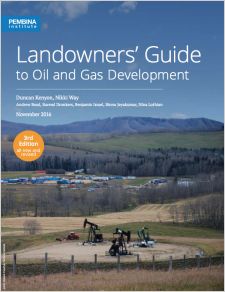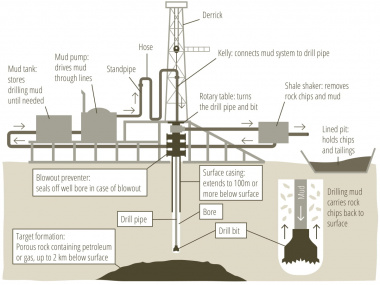Alberta Landowners Guide, Overview of Oil and Gas Wells
 3rd edition | |
| Authors: | Duncan Kenyon, Nikki Way, Andrew Read, Barend Dronkers, Benjamin Israel, Binnu Jeyakumar, Nina Lothian |
|---|---|
| Publisher: | Pembina Institute |
| Publish Date: | October 2016 |
| PDF Download: | [Landowners' Guide] [Landowners' Primer] |
| Initiation Phase | |
| Exploration Phase | |
| Development Phase Overview of Oil and Gas Wells Before Drilling Questions About Lease Agreements Sour Oil and Gas and Emergency Response Hydraulic Fracturing Environmental Considerations of Hydraulic Fracturing | |
| Pipelines and Other Infrastructure | |
| Environmental Impacts | |
| Abandonment and Reclamation | |
| Compensation, Rights, and Hearings | |
| Appendices | |
Contents
Oil and Gas Wells
As an oil and gas well is a long-term project, it is important to understand the details and process of drilling for oil and gas in Alberta so that you know your rights when it comes time to sign a lease on your land.[1] Although the company is required to provide some information when they approach you to negotiate a surface access agreement, this chapter contains additional questions and information that you should consider carefully before you sign your name. If your well will contain sour gas (hydrogen sulphide, or H2S), the company must meet additional requirements, which are summarized in this chapter as well. Finally, this chapter examines specific issues that you need to consider with respect to the construction and operation of hydraulic fracturing wells, a relatively newer form of oil and gas production in Alberta. While hydraulic fracturing uses similar equipment as other conventional oil and gas wells, the operations are generally more intensive and come with some unique considerations for maintaining your property and protecting the surrounding environment.
| Each year the Alberta Energy Regulator receives more than 47,000 applications related to oil and gas operations.[2] |
|---|
Overview of Oil and Gas Wells
Application for development
If a company has discovered a prospect of oil or gas, they will lease the mineral rights for development of that resource from Alberta Energy or from freehold mineral rights owners. Before they can actually develop the oil or gas, the company must submit a resource application to the Alberta Energy Regulator (AER). The AER needs to ensure that the company’s plans optimize the extraction of the oil or gas but don’t interfere with other companies that have adjacent mineral rights.
Well spacing
Traditionally, standard surface well spacing is one well per section (640 acres) for gas wells and one well per quarter section (160 acres) for oil wells.[3] Shale gas and coalbed methane wells are exempt from traditional spacing requirements, so well activity will likely be much denser.[4] A company that uses horizontal fracturing may apply to the AER for a higher surface well density and use one pad for multiple wells drilled horizontally in different directions. Spacing units are described in AER’s Understanding Oil and Gas Development in Alberta,[5] which a company is required to give each landowner affected.[6] Applying for reduced spacing units and directional drilling is now a common practice in Alberta, so it may be common in your area,[7] and take the form of multi-well pads.
A company is not required by the AER to notify landowners and occupants if it wants to
use higher well density than is the AER norm, but they may do so if the project is
contentious.[8] If you have concerns about an application for special well spacing, you can
notify the company of your concerns and submit a statement of concern (see When the Application is Filed: Submitting a Statement of Concern),
which would result in the application being considered non-routine.[9] However,
objections to well spacing by a resident or landowner will likely have to be addressed in
the negotiation process for the project as a whole (see Direct Negotiations With a Company (For Issues Other Than Compensation), through an the
Alternative Dispute Resolution process (see Working with the Alberta Energy Regulator) or a public hearing (Public Hearings and Regulatory Board Processes). If
the company and landowners/occupants are unable to agree on the closer well spacing
during the negotiation process, the company must report this to the AER when filing
the resource application.
| The AER has developed an Alternative Dispute Resolution (ADR) program which helps resolve issues and disputes between stakeholders. Any stakeholder involved in an energy dispute may contact the ADR team at any time for information and assistance. The ADR team will assist in arranging the logistics of a dispute-resolution meeting and will help with the preparation and facilitation of different options including direct negotiation, AER staff mediation, third-party mediation, and arbitration.[10] More information about the ADR process is found in Working with the Alberta Energy Regulator. |
|---|
Disposal wells and CO2 storage
While this section is primarily concerned with oil and gas wells, it is appropriate to note here the AER process for regulating disposal wells. AER Directive 065 includes notification requirements if a company wants to drill a well to dispose of oilfield or industrial waste. Landowners and occupants within 0.5 km of the proposed disposal well are to be notified,[11] and the company has to check that they do not have any outstanding concerns. If a company is applying for approval for the underground disposal of acid gas or underground gas storage, the public will be notified if it contains any hydrogen sulphide (H2S) through the distribution of an emergency response plan (see Emergency response plans).
AER Directive 065 also regulates the use of carbon dioxide (CO2) for enhanced oil
recovery or underground storage. In the near future, CO2 will most likely be primarily
used for enhanced oil recovery, replacing some of the water currently used to maintain
the pressure in depleted reservoirs. In the future there may be an increase in carbon
capture and storage (CCS) operations, where CO2 is captured and stored underground
solely to reduce releases of this greenhouse gas to the atmosphere.
References
- ↑ This material is from the Pembina Institute publication 'Landowners' Guide to Oil and Gas Development, 3rd edition (2016)'
https://www.pembina.org/pub/landowners - ↑ AER, 2015/16 Annual Report, 47. https://www.aer.ca/protecting-what-matters/reporting-on-our-progress/annual-report-and-opinion-survey/annual-report-archives.html Mud. This link has been updated since the 2016 publication; the updated link may no longer contain the original information.
- ↑ AER, Directive 056: Energy Development Applications and Schedules (2014), A-44. AER Directives are available at AER, “Directives.” https://www.aer.ca/regulating-development/rules-and-directives/directives.html. This link has been updated since the 2016 publication; the updated link may no longer contain the original information.
- ↑ AER, Bulletin 2011-29: Changes to the Province-Wide Framework for Well Spacing for Conventional and Unconventional Oil and Gas Reservoirs. (October 6, 2011). https://www.aer.ca/regulating-development/project-application/application-process/special-well-spacing-standard.html. This link has been updated since the 2016 publication; the updated link may no longer contain the original information.
- ↑ AER, Directive 056, A-44.
- ↑ AER, Directive 056, section 2.2.2.
- ↑ AER, Directive 056, A-44.
- ↑ AER, Directive 065: Resource Applications for Conventional Oil and Gas Reservoirs (2010), section 7-11.
- ↑ AER, “Non-routine Public Involvement Authorizations.” https://www.aer.ca/regulating-development/project-application/application-process/nonroutine-technical-authorizations.html. This link has been updated since the 2016 publication; the updated link may no longer contain the original information.
- ↑ AER, EnerFAQs: All About Alternative Dispute Resolution (ADR) (2015). EnerFAQs and Fact Sheets are available at AER, “EnerFAQs (Q&As)” https://www.aer.ca/protecting-what-matters/giving-albertans-a-voice/alternative-dispute-resolution.html. This link has been updated since the 2016 publication; the updated link may no longer contain the original information.
- ↑ AER, Directive 065, section 21.
| ||||||||||||||||||||||||||||||||||||||||||||

